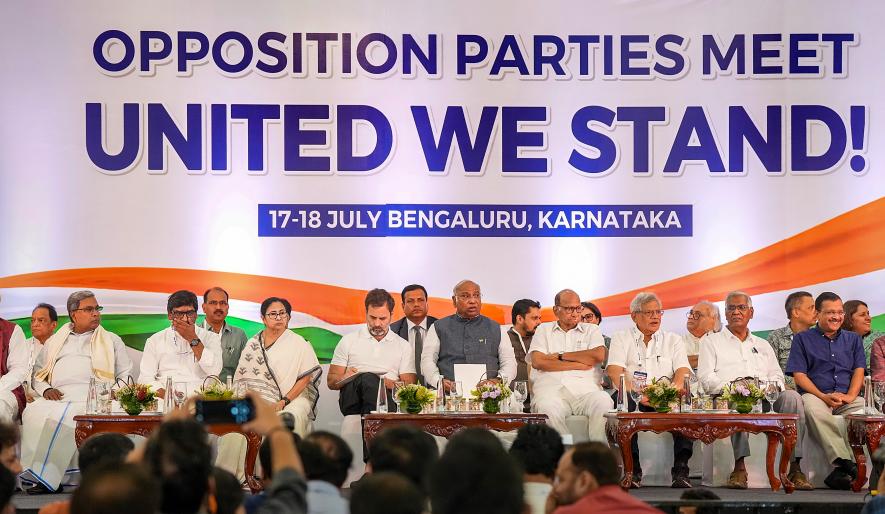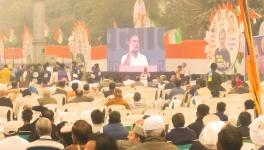Does the Opposition Have a Strategy for the 2024 Lok Sabha Election?

Congress President Mallikarjun Kharge, party leader Rahul Gandhi, West Bengal CM Mamata Banerjee, Delhi CM Arvind Kejriwal, NCP supremo Sharad Pawar and others at a press conference after the opposition parties' meeting, in Bengaluru, Tuesday, July 18, 2023. Image Courtesy: PTI Photo/Shailendra Bhojak
The question that seems to matter the most today is whether the opposition INDIA alliance has a clear strategy for the 2024 Lok Sabha election. Strategies emerge in the course of politics, and based on the response to them, ideas hit the ground. Strategies begin and end with trial and error, and politics inaugurates new ones in the field. Today, the Bharatiya Janata Party (BJP) is not only making sure that it has a clear strategy but that the opposition lacks one. It is coming down heavily on anything with the potential to create momentum for the INDIA alliance.
The opposition has had its moments of glory. It began the last Lok Sabha election well, with the narrative that the BJP is a “Suit-boot ki sarkar—government of the well-heeled”. Rahul also coined the slogan, “Hum do, hamarey do—We and our two”. Soon after, we saw BJP president JP Nadda play a more central and visible role in offsetting the accusation.
But even when it has no response to accusations, the Prime Minister Narendra Modi government comes down heavily to disrupt counter-narratives. Congress spokesperson Pawan Khera proactively called out the Prime Minister’s proximity to business tycoon Gautam Adani with the term “Adani Das”, but he was soon arrested, and that was the last we heard of that slogan.
Similarly, the Aam Aadmi Party (AAP) was getting many things right, even if it meant a compromised strategy that had it occasionally take very problematic positions or silences, as during the anti-Citizenship (Amendment) Act protests. The BJP sensed early on that AAP could potentially create a narrative that would breach the BJP’s hold over Hindu voters. It also sensed that breaking the hold of AAP over Delhi would not be very easy. So, it came down heavily on the party through the central investigative agencies.
The BJP goes so ballistic in its offensive that it damaged AAP’s clean image and disrupted the emergence of a clear counter-narrative against itself. The BJP hurts and arrests the momentum of counter-narratives to the extent that AAP, which was pushing an anti-corruption narrative, has slid into defending its own credentials.
Similarly, the INDIA alliance lacks the momentum it requires because the BJP seems to understand where the potential for an effective counter-narrative exists. The BJP not only crushes the momentum of narratives but follows up with deviation and setting up red herrings. What this does is protect Modi’s Teflon-coated image. It does not allow people to think clearly about what the opposition is saying. Nor does it allow the infallible image of Modi to slip.
Further, the Prime Minister tries to gain advantage of criticism directed at him. He tries to gain sympathy and disallows it from converting into a generic critique. The opposition hasn’t demonstrated the energy, intensity and conviction to push something in response. Instead, it goes along with the booby traps laid by the regime. As a result, the crushing of the opposition’s momentum begins to be seen as lack of momentum. And the opposition is unable to shift gears because the BJP is faster and better organised.
What this does is that despite the BJP having been in power for ten years, Modi has occupied the opposition space and that of the underdog. He is less effective as a policy-maker or a statesman, being more of a ‘protester’ and provocateur. He began with the projection as an outsider to Delhi, moved to resent the ‘slavery of the past’, mobilising resentment against the Congress party’s misdeeds, and now he is about reaching a global stage against imperial interventions thwarting a resurgent India—and from there, his narrative goes planetary!
Modi is a permanent underdog taking on the biggies of the world. His image-making doesn’t allow the opposition to become the protesters but default conspirators against those who are struggling. So, the opposition first needs to become an opposition, which can only happen if it is willing to protest—hit the streets to generate counter-narratives without letting up. It has not been able to do this. Opposition leaders still look like ‘leaders’ and a ruling elite because they have not hit the ground running.
Rahul Gandhi is the only leader who has been able to make this transition, and it could have set the momentum for the opposition, but the Congress party lacks the organisational strength to take his narratives to the ground. What Rahul says remains in limited circles, and his own party’s leaders look unconvinced by what he says and does. There is no organisation to convert his words and actions into a local idiom and carry it to the last mile. The BJP, on the other hand, is dishing out limited benefits but, through sheer organisational might, connecting with voters in a personalised and individualised manner through door-to-door campaigns. Personal contact has the potential to generate a lot of trust and optics of accountability, while the news of infighting within the Congress party undermines trust. The BJP has converted its centralised, top-down, and authoritarian model to make it look like a disciplined and duty-bound activity.
Congress won the Telangana Assembly election against all the odds—especially its lack of money and manpower—because it succeeded in occupying the space of an opposition struggling against a regime. The INDIA alliance also needs an agenda to protest for, an agenda the Modi government is unwilling to implement but which is good for the majority. What could be such a socially transformative strategy? The caste census began with a certain momentum, but it would have been infinitely more effective had the opposition got the census done and then fought for its benefits—merely conducting a census may not be a game changer, just as promising reservation to women after ten years was a non-starter for Modi.
Ideally, the opposition should go with concrete policies related to the various disadvantages that, say, the caste census in Bihar has highlighted—that would be an agenda well beyond the transactional welfarism that the Modi regime has successfully implemented.
What one needs to concede is that the Modi regime doesn’t take anything for granted and is alert to the signals from the ground. Alongside, it sets up red herrings and back-door alliances while employing diversionary and devious tactics. It has a multi-pronged strategy with multiple checkpoints. All these can be taken on only with great momentum and an opposition counter-narrative that offsets many of its disadvantages, including being short of money, power and manpower.
Such a momentum cannot be built through anti-Modi rhetoric but a pro-poor agenda that goes well beyond what the current regime promises. A robust social agenda worked in favour of the Congress in Telangana, where the party looked more radical and committed. This is the image makeover the INDIA alliance requires, but the danger is that bringing so many parties together might, once again, make Modi look like the underdog as well as the opposition!
The author is an associate professor at the Centre for Political Studies, JNU. His new book, Politics, Ethics, Emotions in ‘New India’, has been published by Routledge. The views are personal.
Get the latest reports & analysis with people's perspective on Protests, movements & deep analytical videos, discussions of the current affairs in your Telegram app. Subscribe to NewsClick's Telegram channel & get Real-Time updates on stories, as they get published on our website.





















